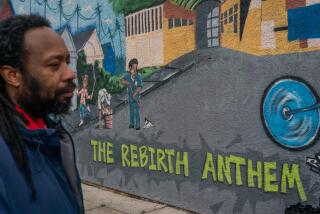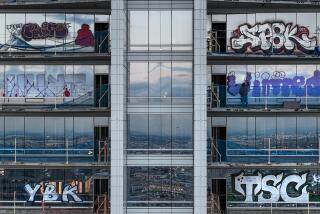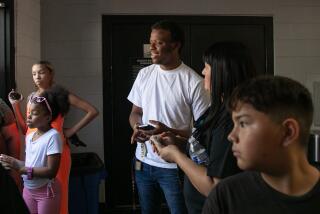In Watts housing project, ‘the wall’ pays tribute to community’s dead

Here in the Nickerson Gardens public housing project in Watts, it’s simply called “the wall.”
On it, written in black in Old English script, are the names of the dead.
The first names to grace the wall were those killed in gang violence, but there are also names of people who meant something to the community.
There’s Nora King, a longtime community activist in the housing project, who died in 2004 at age 70.
There’s the son of Barbara Singleton, who has lived here since the 1970s. Carl “Scoop” Singleton was 16 when he died in a moped accident.
The wall started as a mural on the front of the recreation center gym in the early 1980s. Clifford Baynes Jr. painted figures such as Martin Luther King Jr. and Rep. Maxine Waters, said Greg Brown, who grew up in Watts and was one of the mural’s founders.
As time went on, the list of names replaced the artwork. Now, they’re painted in rows. A yellow banner reads, “Keep the future alive.” Another says, “Gone but not forgotten.”
As word spread, more people wanted names to be added.
“The wall is there for everybody,” Brown said.
In a community plagued by unemployment, poverty and gangs, the wall is sacred ground. Everyone, from children to adults, knows not to lean against the wall or put their feet up on it. The taggers stay away from it.
“You can come here any time of day, any time of night,” said Donny Joubert, who mentors young people here and whose mother’s name adorns the wall. “I don’t care what’s going on. They respect this wall.”
Eddie Williams, who has lived in the development since 1983, said his two brothers are on the wall.
Derrick Jennings died in a walk-up shooting in 1992, and Ricky “Slick” Jubert died three years ago in an accident.
“I walk by, I put my hands on it and I kiss up to the sky,” Williams said.
Though Williams throws a party each year in their memory, the wall is his daily reminder.
“I love it being there, that I can just walk up and see their names.”
On Wednesday evening, a gaggle of children chased after one another outside the gym, the wall serving as their backdrop.
Donna Moore sat on a nearby bench, watching the kids play. More than 30 years ago, her brother, Jeffrey Moore, was standing in his frontyard when he was sprayed with gunfire. Moore has taken her granddaughter to the wall to point out his name.
“When his birthday comes up, I come to the wall,” she said.
Hank Henderson, who was raised in Nickerson Gardens and works at the housing authority, said people commonly mistake the wall as a tribute to those lost in gang violence. A mural on part of the wall reads, “Nobody can stop this war but us,” surrounded by rope in red, blue and purple — the colors of the local gangs. But it’s more than that.
“It’s history,” he said.
To Henderson, the wall represents pride in his community. His mother and father’s names are up there. In 2009, his son joined them.
Rayshawn K. Boyce, 31, was killed in a walk-up shooting. He left behind three children.
“I never wanted to see my son up there,” Henderson said, standing inches from his son’s name.
Now, Henderson is a steward of the wall. He will keep it going, just as those before him did.
More to Read
Start your day right
Sign up for Essential California for news, features and recommendations from the L.A. Times and beyond in your inbox six days a week.
You may occasionally receive promotional content from the Los Angeles Times.







